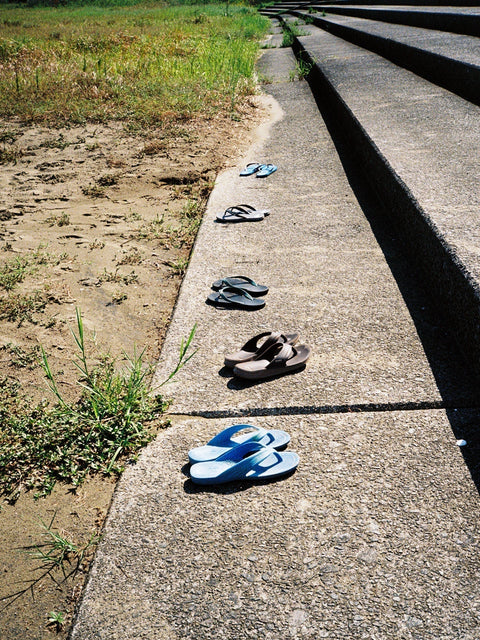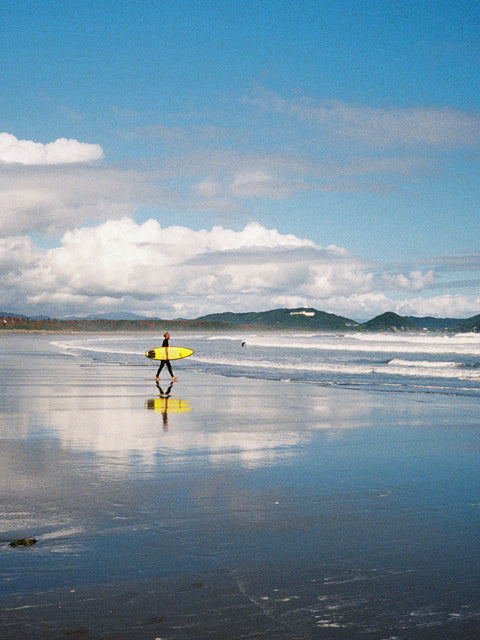
Surfing Japan: A Cultured Guide for the Curious Surfer
When people think of traveling in Japan, city breaks in Tokyo, temple visits in Kyoto, or perhaps snowboarding in Niseko often come to mind. Surfing, however, rarely enters the conversation. Yet, for those willing to look beyond the obvious, Japan offers a chance to ride waves surrounded by striking scenery, infused with culture, and punctuated by unforgettable meals.
Japan might not boast any world-renowned waves, but what it lacks in big-name breaks, it more than makes up for with variety and a surf culture that is entirely its own.
 From laid-back beach breaks to reef setups and river mouth waves, Japan quietly caters to surfers at every level, rewarding curiosity and exploration.
From laid-back beach breaks to reef setups and river mouth waves, Japan quietly caters to surfers at every level, rewarding curiosity and exploration.
Last October, we spent ten days tracing the rugged coastline of the Miyazaki peninsula, followed by a brief but memorable stop in Ichinomiya, Chiba, before returning home. When we began planning our trip, aside from a couple of blog posts that describe different areas (I’ll link to these at the end) useful information in English was surprisingly scarce. The experience inspired us to share this guide—filled with the tips, insights, and practicalities we picked up along the way—to help you navigate your own Japanese surf adventure.
1. Rent a Car
Although Japan is famous for its fast and convenient trains, a rental car is essential if you plan to explore surf breaks and move easily between regions. A small minivan or one of Japan’s ubiquitous "box cars" is ideal to comfortably fit your surf gear and boards. Remember, you'll be driving on the left side of the road, which might take a minute to get used to—but don't worry, there’s no horn-honking or aggressive maneuvering here. The Japanese drive with the same refined comportment that they extend to all aspects of life.
You’ll need to get an International Driving Permit before you go, available from your local AAA or DMV (around $20), remember you’ll need to take a passport photo for the application.

2. Get Access to the best rental boards without spending a fortune
This one was the diamond discovery of our trip. If you’re not bringing your own board, Surfboard Station, run by Japan’s largest board-sports retailer, Murasaki Sports, is the place to go. Unlike traditional board rentals, Surfboard Station operates through a monthly membership, which initially might sound off-putting—until you realize the monthly rate is roughly equivalent to a standard three-day rental elsewhere. Though their website suggests downloading an app to sign up, we were able to register in person at the store (just bring your ID).
Their boardrooms in Miyazaki, Shonan, and Chiba are exceptionally well-stocked, featuring an extensive range of boards in excellent condition. There are plenty of high quality shortboards, mid-lengths, and longboards to choose from, from independent shapers to well known brands like Pyzel and Channel Islands. We strongly recommend trying something from one of the local Japanese shapers; their boards are thoughtfully crafted to suit the waves of the region. Once you’re a member, you can pick up a board at any Surfboard Station location across Japan, and switch boards as often as you would like, giving you complete freedom to experiment with different shapes as conditions change. They also rent fins, so you can select the ideal fin setup for each board you try, but you'll need to bring your own leash or purchase one there. The only slight inconvenience is the requirement to check your rental board in every few days.
Click Here to learn more about Surfboard Station by Murasaki Sports
If you prefer traveling with your own board, prepare for some logistical challenges. While Japan’s famously efficient trains are great for normal travel, carrying a surfboard can complicate matters. The Shinkansen (bullet train) imposes strict size limits on luggage, and large board bags often exceed these restrictions. If you decide to risk it, make sure to reserve an oversized luggage seat in advance. Additionally, local taxis generally won’t accept oversized surfboards, making a rental car your best—and probably only—practical option.
 3. Forget Surfline: Use "Catch the Wave"
3. Forget Surfline: Use "Catch the Wave"
Although Surfline has mapped out the main spots and does give the tide information and a forecast based on the buoy readings, they have very few cams. Japan’s local surf app, Catch the Wave, is the go-to for wave information for approximately 120 locations across Japan, videos with explanations for over 50 locations, and live camera footage.
 4. Go at the right time & Manage your expectations
4. Go at the right time & Manage your expectations
Japan technically has waves year-round, but the prime surf window runs from August through November. During our late-October trip, we scored consistent chest-to-head-high waves and ideal conditions, making for a relaxed surf adventure. September through November overlaps with typhoon season, meaning there’s always potential for significant swell—but it can be highly unpredictable.
Expect shorter-period swells and wind-driven surf and soft take-offs that gradually steepen into punchier inside sections. Beach breaks might appear underwhelming at first, yet often deliver surprisingly enjoyable rides. We found these waves were ideal for refining turns and gaining confidence on steeper sections without an intimidating take-off. Consider renting a board with a little extra volume until you get used to the mushier conditions.
Think of a surf trip to Japan as less of a hardcore surf trip and more about combining laid-back surfing with an enriching cultural experience.
5. Respect the Local Surf Culture
Japanese surf culture is polite, relaxed, and quietly refined, making respect in the lineup essential. Resist the temptation to paddle straight to the peak, instead, take a moment to observe the flow of the session, be mindful of your surroundings, and keep noise to a minimum—locals appreciate visitors who tune into their rhythm. Familliarizing yourself with basic Japanese etiquette before your trip will help you avoid unintended faux pas both in and out of the water.
Beyond etiquette, there's something special about witnessing the unique rituals that bookend a surf session in Japan. Surfers here treat their boards with reverence, almost as samurai would their sword: they carry personal board stands to keep their boards off the ground, and use specially designed drying racks that attach to the open trunks of their vehicles.
There’s also a thoughtful appreciation of surfing as a deep connection to nature, paired with a quietly thriving women's surf scene.
Picture mid-length boards, single fins, and refreshingly, no one yelling nonsense in the lineup.


6. Bring the right gear
Sun protection is essential—don’t underestimate the UV, even on overcast days. The Japanese take sun safety seriously; expect to see surfers wearing hats, gloves, and leggings as standard. During our late-October trip, the Trestles 1mm Springsuit paired with leggings was perfect for Miyazaki’s mild water temperatures. Chiba, however, was noticeably chillier. Since we were only there briefly, we made do—but for a longer stay in that area, especially if you're sensitive to cold, I'd recommend bringing at least a 2mm full suit or even a 3:2 in October. Check water temperatures before you pack and plan accordingly.

7. Convenience Stores Are a Surfer's Best Friend
Japan’s iconic convenience stores—7-Eleven, Lawson, and Family Mart—are indispensable for surf travelers. Whether you've forgotten your socks, run out of clean underwear, need an iPhone cable, or just a satisfying snack, they’ve got you covered. Their onigiri (rice balls) are an affordable, tasty, and convenient pre- or post-surf snack, and there's a huge selection of drinks, snacks, and deliciously quirky Japanese candy to explore. If you're staying in a surf town, there's even a chance you'll spot a vending machine outside stocked with surf wax. Forgot your wax at 5 am? No problem!

8. Be Prepared to Carry Your Trash
Japan is famously clean, but public trash cans are few and far between. Expect to carry your trash until you find an appropriate disposal point. Bringing a small trash bag to keep in your rental car is a smart move—and fortunately, when you do find it, there's typically recycling available. Be ready to sort accordingly.
9. Language Barrier? Google Translate is Key
English can be scarce in rural surf towns, so learning a handful of essential Japanese phrases is helpful. Google’s translation feature will quickly become your best friend—especially when deciphering menus, navigating directions, or handling simple interactions. Keep in mind, though, it's not always foolproof: we learned that the hard way when a translation mishap landed us face-to-face with an unexpected plate of raw chicken sashimi. Thankfully, 93% of human communication is non-verbal—so when in doubt, a friendly smile goes a long way!


10. Embrace the Local Cuisine
Japan’s culinary offerings are exceptional—but if you're a picky eater, be prepared to step outside your comfort zone. From world-class sushi to cozy izakayas and flavourful street food, the variety is endless. After hours spent in the water, there’s nothing better than warming up with a steaming bowl of ramen.
11. Bring Local Currency
Japan remains heavily reliant on cash, especially once you leave the major cities. Smaller businesses, rural eateries, and toll roads often won’t accept credit cards, making yen essential. ATMs are relatively easy to find (check any 7-Eleven, Lawson, or Family Mart), but be sure to get some cash before picking up your rental car—you’ll need it for the tolls along your route.
12. Connect with people
Some of our most memorable surf experiences came directly from chatting with local surfers. Friendly conversations in surf shops led us off the beaten path to breaks we wouldn't have discovered otherwise. In Chiba, we were lucky enough to meet up with our friend Taku, who showed us around. Like any meaningful travel experience, connecting genuinely with locals enriches your journey, deepening your appreciation for the surf, culture, and country. After all, it's often these spontaneous, personal interactions that stay with you long after the waves fade.

13. Visit the Tamasaki Shrine in Ichinomiya

14. Experience an Onsen
There’s nothing more authentically Japanese—or restorative after a long day surfing and exploring—than soaking in a traditional onsen. These geothermal hot springs are an integral and cherished part of Japanese culture, offering relaxation for both mind and body. Beyond their therapeutic benefits, onsens provide an intimate glimpse into Japan’s gentle appreciation for tranquility and self-care. If you're in Miyazaki, the ANA Holiday Inn in Aoshima has a spacious traditional onsen overlooking the surf break—ideal for unwinding.
15. Explore the Range of Accommodation Japan Has to Offer
From tiny homes to historical gems, Japan’s coastal towns have a wide range of accommodation options to suit every type of traveler and budget. Whether you’re looking for something minimalist and modern or traditional and immersive, it’s worth exploring different areas and styles. The diversity of stays adds an extra layer of character to your surf trip and makes the experience all the more memorable.

From waking up in a 200-year-old samurai house from the Edo period to discovering a tiny home hidden deep in the forest, savouring the culinary delights of family-run soba spots, and marvelling at the striking geological formations of the ocean floor at the famed Devil’s Washboard at low tide—a surf trip to Japan is an immersive journey through scenic coastlines, vibrant culture, and countless unexpected moments of joy.
Surfing, after all, is a passion that invites us to explore cultures and places we might never otherwise experience. Each destination broadens our understanding of the world, reminding us why we became surfers and travelers in the first place.
Check out our photo journal of the trip for a visual daydream.
→ Lineups & Landscapes: Surfing Japan Through Our Lens
And for detailed information about specific surf regions across Japan, these two sites are invaluable resources:
https://www.japansurf.jp/surf-area/
https://www.surfinginjapan.com/surfing-in-japan



